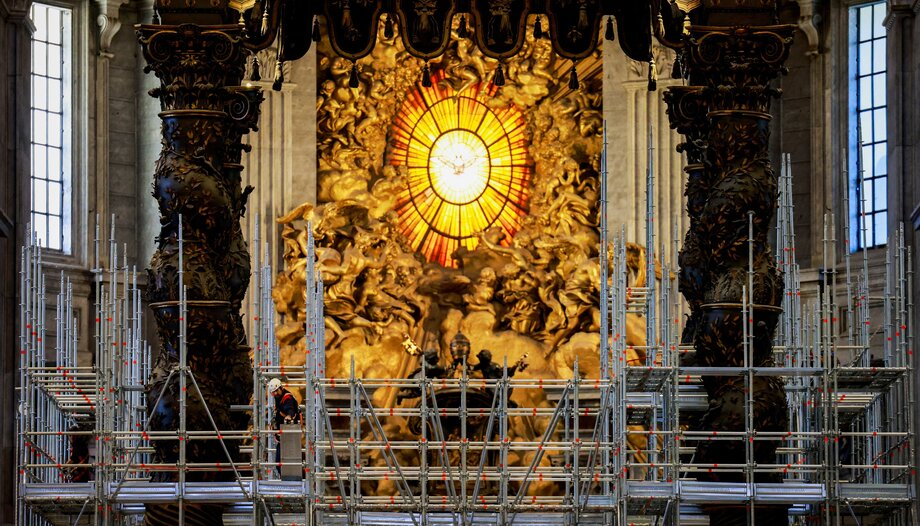The restoration of the baldachin of St. Peter's will be completed on October 27 and the San Pedro Factory organized a visit that allowed journalists to climb the scaffolding to admire the works firsthand.
"The restoration is a memorable event," commented Cardinal Gambetti, the Pope's vicar for Vatican City and archpriest of the Vatican basilica. Gambetti explained how the date chosen to unveil the baldachin is "significant because it recalls the day of prayer for peace desired in Assisi by John Paul II and because it concludes the synod with a solemn Eucharistic celebration." The Pope, the cardinal added, visited the works and appreciated the work done.
The cardinal went on to say that the baldachin "has been restored to its original splendor and thus expresses the meaning of what the basilica contains, the beautyThe Eucharist expresses all this better than any other event. The Eucharist expresses all this better than any other event. The pallium says it before the tomb of Peter, the first witness to the faith. In the Eucharist shines forth the beauty of the Church, a reflection of what Jesus did by shedding his blood on the altar of the cross, and later what the apostles and their successors did. The fact that we can once again admire the munificence of this apparatus is, I believe, an opportunity to thank it. We are walking towards the jubilee of hope. I am convinced that something will happen, every jubilee is a step in history".
Gambetti also announced that the ancient seat of the Chair of Peter, taken from Bernini's Gloria in the apse of the basilica, will be displayed for the veneration of the faithful. Scientific analyses are being carried out to guarantee its conservation: "Few have seen the seat, we will place it at the foot of the baldachin until December 8 to admire this testimony of the apostolic tradition," the cardinal concluded. The last time the chair was exhibited was exactly 50 years ago, in 1974.
Restoration of the baldachin
The restoration, directed by engineer Capitanucci and Dr. Zander, employed a team of restorers and members of the Vatican laboratories, and was carried out with the support of the Order of the Knights of Columbus. In addition to the baldachin and the cathedra, the glass of Michelangelo's Pietà is also being restored.
Capitanucci explained the difficulties of access to the canopy. The last major restoration took place about 250 years ago. It was nine months of work, of which the first 45 days were dedicated only to taking samples and perfecting the technique. "All this" - he continued - "has also allowed us to intervene in the chair".
Restoration details
Capitanucci highlighted two details. The first is technical: the shine of the gold will be the element that will stand out in the center of the basilica, but then "there is the color of the leather effect that has highlighted the cleaned bronze". The canopy, in fact, has the size of a palace (about 30 meters at the cross), but the conception with which it was made is that of a processional element, one of the cloths that accompanied and covered the celebrants.
The second is an aspect of the "lived life". Apart from the signatures of the "sampietrini", the workers who worked on the construction and restoration of the work, "many elements have been found that refer to minute life: from remains of nuts to cigarette packets from the 1920s, to expense notes, even from the eighteenth century, small drawings and coins and inscriptions such as "I came with my son and tomorrow he will come in my place". Objects thrown into the wooden cavity under the four large angels. Which shows, Capitanucci concluded, that "the canopy is supported by human effort".
The materials
Giorgio Capriotti, one of the restorers of the team of four companies that collaborated in this undertaking, explained that the most difficult thing "was to coordinate in a short time focusing on conservation issues, which are complex. We have a polymeric monument, composed of bronze, with the problem of oxidation that comes with such a large environment, with exposure to dust and what is deposited on the parts of the canopy. Then there was the problem of substances that arbitrarily overlapped during routine maintenance and had to be removed. The luster of the gold could only be perceived under very bright lights. This method was also used for the chair."
In addition to bronze, the materials used to manufacture the canopy are embossed copper, both with gilding, in the most visible parts with up to seven layers of gold leaf; and wood, in the sky and in the ribs of the attic of the structure, covered with gilded copper. The interior of the columns, made of cast bronze with all the figures in one piece, is filled with concrete, which supports the entire structure like gigantic pillars. It also sits on a "risky" area, because underneath is the void of the Vatican grottoes: "Both the engineers who built the canopy and our engineers who built the scaffolding, which weighs several tons, had to calculate how much weight the floor could support," Capriotti continues. Now the problem will be maintenance to preserve this shine and "the Vatican Museums are carrying out studies, with more effective control and methods to remove the particles".
Finally, preliminary conservation analyses of the relic of St. Peter's chair relic are underway, while the restoration of Bernini's Gloria, where the chair is normally kept without being visible, will be completed on November 11.
-Rome








